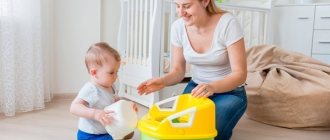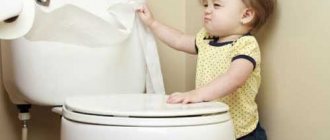Many new mothers dream of getting rid of constantly wet diapers and expensive diapers as soon as possible. That is why the question of how to teach a child to poop in a potty is the most pressing among young parents. In order to develop neatness skills faster and without unnecessary problems, first of all you should take into account the age of the baby and follow all the principles of training.
Baby poops
When to potty train your baby
Many pediatricians say that the optimal age when a child can be potty trained is 18-24 months. During this period of life, psychological and physical maturation occurs, and the baby is already able to learn all the skills of neatness.
Note! The period of formation of the necessary conditioned reflexes is individual for everyone. Some children can consciously go to the potty as early as one year old, while others continue to pee and poop in diapers until they are three years old.
Early disembarkation of the baby
A newborn baby does not yet realize that he wants to poop or pee. He simply feels discomfort or slight pain in the genital area. He does not know how to control his sphincters and, making various sounds, asks his mother for help. Early child care is considered one of his important needs.
If the parent gently pats the baby’s genitals and points to the exact place where the area of discomfort is located, the baby will be able to relax the sphincter. If the parents have mastered the planting technique, the baby will quickly learn to control his sphincters and learn to endure.
Also, the early planting method helps to establish close emotional contact between the mother and the child, since the baby must be observed all the time in order to learn from the first second to understand all the signals that it gives. In addition, early planting will relieve parents from the problem of potty training their baby.
If the baby was started very early, then most likely he will ask to go to the potty much earlier than his peers. The advantages of early planting also include significant savings on diapers, which cost a lot of money.
Baby on the toilet
Training methods
As you already understand, the learning process will require patience and endurance from you. To make your task easier, read carefully a few valuable tips. If you decide to teach your child to pee and poop in the potty, the most important thing is not to scare him away. Don’t be too persistent so that your baby loses interest in a new subject. Try to imagine the potty as a toy: explain the functional purpose of this item, describe its advantages. For example, place a doll or plush toy on it. Let the child make sure that the new object does not pose any danger to him. If you have older children in the family, they can become a visual object. For the most part, the youngest always want to be equal to their elders. In order to explain to your little one the usefulness of this device, start small. Tell them that walking around with a wet or dirty bottom is unpleasant and unsightly. In order to avoid these sensations, there is a potty. You'll see, when the baby understands what his advantages are, he himself will run to poop on him. If he succeeds, don’t forget about encouragement. If you do everything correctly, the child will have a feeling of pride and he will want to repeat the action that managed to please his parents. Make sure that the necessary item is always within reach. This will make it much easier for you to accustom your baby to it. If the baby does not find or reach his toilet, then he will even lose the desire to look for it. The potty should be in the children's room so that the child has the opportunity to become interested in a new thing and get used to it. When you notice that the baby has already become acquainted with an unknown object, begin to sit him there for a few minutes. Don’t be lazy to constantly remind your baby why the potty was created. You need to put your child on it every time he wants to pee or poop. You can resort to little tricks. For example, allow your baby to flush the toilet every time you empty the potty. Read interesting and favorite books while trying to train your baby. But don't get carried away, because the act of going to the toilet should not be a performance for your baby. It is necessary to distract him only if he has fear or negative emotions towards the potty.
If your child refuses to sit down to poop, don't be persistent. In this way you will not be able to accustom him, you will only develop fear in him. The most important thing is to set the baby up correctly. He shouldn't see the potty as a threat. If the baby flatly refuses to sit on it, come up with an alternative. For example, a boy can be taken to an “adult” toilet, and a girl can be offered a basin or any other container. Don't make comparisons. Remember that your baby is an individual. If your neighbor's child is no longer afraid of the potty, this does not mean that you should immediately re-educate yours. Parents should be attentive to their child so that he quickly understands what you expect from him. If you notice that your child is acting strangely, bring the potty immediately. After he has successfully completed his business several times, he will ask to go potty on his own. So, in order to ensure that the result does not keep you waiting, take into account the following tips and recommendations:
- A baby quickly gets used to the potty only at a certain psychological age.
- Your child should poop in the potty as soon as he wakes up. Even if he doesn’t feel like it, it’s important that he just sits on an object that’s new to him.
- You should not start training when your child is sick or unwell. This way you will achieve nothing but hysterics and fear of going to the potty.
- At first, don't give up diapers completely and don't scold your child if he urinates in his pants.
Now let's look at several techniques that will help you potty train your baby. The first method will take you a week to complete. It was approved by the majority of mothers, so you can be confident in its effectiveness. If your baby is one and a half years old, but she is still not potty trained, then try the “Voluntary Baby” method, which was developed by Gina Ford. At the same time, your baby should be able to perform simple actions: undress independently, understand mother’s words, etc. On the first day, remove the diaper from your baby immediately after sleep. Motivate your little one with the fact that he is already big, and adult children do not need such things. Tell your child why people go to the toilet, and also explain that a potty is the same as a toilet, only for small children. If your child is unable to relieve himself, take him to the toilet every fifteen minutes. Do this until he understands what you expect from him. You can sit next to her and entertain the baby so that she is not afraid and does not jump up from the potty. Even if you didn’t manage to catch the moment and the baby relieved itself in his pants, don’t be upset - next time you’ll succeed. On the second day, it is necessary to consolidate the acquired skills. Monitor the behavior of the baby so that she does not play, but relieves herself. On the third day, you need to continue with the same pattern of behavior as in the previous days. Do not wear diapers even if you go for a walk. This way you will only confuse your baby. He must be clearly aware that he needs to relieve himself exclusively on the potty. Before going outside, invite your little one to use the potty so that trouble does not happen on the street. While walking, ask your child if he wants to go to the toilet. If you have the opportunity, you can take the pot with you. When your baby gets used to holding urination, you won’t have to carry this item with you. After a successful visit to the potty, always praise the baby. Tell her that she is your pride. Perhaps your praise will become an incentive for further learning. Repeat the above procedures for a week. The result will not be long in coming.
Let's look at another technique that will take you three days to implement. Don’t think that this express method will become a panacea for your baby. But you can try. Consistency is important when it comes to potty training. If you don’t rush your little one, the learning process can take up to several months. But there are situations when you need to urgently potty train him. Do not forget that a quick method is not always a necessary effect. Even if you do not achieve the desired result in a short time, you can still instill in your child the need for such an item as a potty. Therefore, you should not despair and neglect at least some opportunity to convey new knowledge to your child. First, let's determine how ready the little one is for learning, and also take care of the necessary conditions. Focus on the age of the baby. Quick methods are only suitable for those children who are already two years old. If you see that your baby can restrain himself for about two hours, and also does not feel comfortable in a diaper, then the time for training has come. Once your baby develops a bowel movement routine, he will poop at approximately the same time every day. If you see that according to all the above signs she is ready for training, then start preparing her. Tell your child that he will soon have to learn something new. This preparatory stage can take up to two weeks. Show your toddler the potty every day and talk about its purpose. Tell them that all children should take this subject, because it is natural and necessary. Talk about how good it is when panties and panties are not wet and the child does not need to wear panties. You can interest your baby in buying new underwear. Buy panties or panties with cartoon animals on them that he will love. For training, always choose a moment when you can fully devote yourself to teaching your baby. It will be easier for you if you have an assistant nearby. To do this, involve close relatives who will help the baby tune in to the right wave. After you have spent a certain amount of time preparing, you can begin to actively train your baby to sit on the potty. When you complete the preparatory stage, we will begin training. If you think that the potty training method in three days has its trump cards, then you are mistaken. You have to do all the same steps as described in the previous method. But the only difference is the intensity of training. You will have to spend a lot more time to make your baby feel comfortable and stop being afraid of this item.
Child's reluctance to poop in the potty
Is it possible to walk with a child with a fever?
Very often, young mothers are faced with such a problem when a baby who knows how to go to the potty suddenly stops sitting on it. If parents persuade and insist, he begins to cry loudly. There may be several reasons for this behavior:
- Changes in the usual routine: the process of adaptation to kindergarten, change of place of residence, birth of a younger sister or brother;
- Quarrels in the family that negatively affect the child’s behavior;
- The baby is teething and has undergone routine vaccinations;
- Once upon a time it was painful for the baby to poop, and he does not want this situation to happen again;
- The child protests in response to pressure from parents;
- Overexcited state;
- The baby has developed a fear of loss (he does not want to part with poop);
- The baby is afraid that his potty will be dirty;
- A recent illness often leads to regression, and the child will have to be potty trained all over again.
Important! If the baby does not want to sit on the potty, this can lead to stool retention and, accordingly, constipation. The baby will protest even more strongly and will not want to sit on the potty at all. If the situation is not corrected, the baby may experience psychological constipation, which is not easy to cure. Parents need to understand why this happens and correct the situation as early as possible to avoid problems in the future.
Boy on the potty
How to potty train a child in 3 days: conditions and rules
In the event that it is necessary to introduce the baby to the potty as quickly as possible (for example, the baby will soon go to kindergarten or go on a trip), parents will find it useful to use emergency methods for teaching children to use the hygienic device.
Of course, in such a short time, not a single child will be able to immediately move from diapers to a potty, but kids will develop a basis for mastering toilet etiquette.
Rules for carrying out the technique
The three-day method will only work if the child is older than one and a half years old, but younger than two years old. In addition, the baby is able to explain in an accessible way that he wants to pee or poop, and strives to quickly get rid of the spoiled diaper.
How to potty train a child in 3 days? First of all, after making sure that the baby is ready for the process, you need to introduce him to the upcoming changes. Such acquaintance begins in advance - about two weeks before active steps.
Preparation consists of several steps:
- buy a potty (if you don’t already have one), explain to your child every day why this device is needed. You can also give instructions to an adult toilet, telling them that the toilet is the same as a potty, but for adults;
- tell them 7 days before the event that you will soon have to get rid of diapers, and instead of them panties and a potty will appear. Buy children's underwear for “adult” children. Let the panties be with images of your favorite characters;
- the mother will need three days in a row to be with the baby all this time. Therefore, you should take Friday or Monday off so that the technique is not interrupted, and enlist the support of your spouse;
- Since you will have to constantly be with the baby for 3 days, you need to prepare entertainment for him and yourself in advance: cartoons, movies, games, books - everything that will allow you not to get bored and irritated.
As soon as you manage to prepare everything, you should proceed to active actions, carefully following all the recommendations of specialists.
First day
In the morning, as soon as the baby wakes up, the diaper is removed. It is permissible to put the child in shorts or leave him to walk around naked, if, of course, the temperature in the room and the season are conducive to this.
The night vase is placed in the children's room, closer to the baby. By the way, you can give him more liquid: water, milk or juice.
This is necessary so that the child wants to empty the bladder. Or simply place a sippy cup with your favorite drink next to your baby.
Parents carefully watch their child, tracking every sign that he wants to go to the toilet.
Ideally, the baby should notice a clear relationship between the desire to pee and being put on the potty. You can put the child on the night vase every 20 minutes.
It is for such painstaking work that at least two adults are needed. There will be a significant workload on them, since each attempt to urinate must be monitored in order for the connection to become firmly established in the mind.
How to potty train very quickly? Be sure to praise your child for every successful attempt.
Moreover, you should not say faceless phrases like “well done,” but specifically explain why you are praising the child: “Good girl for peeing in the potty.”
Failures, on the contrary, must be ignored without paying any attention to them. Moreover, you should not scold or blame the baby so that he does not develop negative associations associated with the potty.
Before going to bed in the evening, you are allowed to put on a diaper. Let the baby get a good night's sleep before the next day.
Second day
Today you can walk outside with your child without a diaper. Naturally, it is better not to go far from home, so that in case of an unpleasant “embarrassment” you can quickly return to the apartment. This is especially true in the autumn-winter period.
They go outside after the baby has peed and pooped. In the warm season, you can take things with you for changing clothes and a second potty for performing natural needs. After a successful attempt, be sure to praise the child.
The third day
In the last 24 hours, you should add one more walk so that the baby can control the process of bowel and bladder emptying both at home and outside.
Before any routine activity (walk, nap), it is necessary to place the child on a night vase. The same procedure is repeated upon returning home and after waking up.
If you don’t know how to potty train a 2-year-old child in the shortest possible time, a three-day course will come to the rescue. At the end of the technique, children usually respond well to the potty, often even sitting on it on their own.
It is best to do without clothes, but if the room is cool, you need to choose the right things - without buttons, straps, zippers and other fasteners. Otherwise, the child will not be able to quickly remove the underwear and will do a “wet or dirty thing” directly into the panties.
Which is better: potty or toilet
2 month old baby's daily routine
Potty benefits:
- Portability. It is light and compact, it can be easily moved from place to place and taken on a trip;
- Low height. When the baby sits on the potty, his legs are on the floor, this provides a more natural position in order to “relieve his need”;
- Safety. Sitting on the potty, the child cannot fall to the floor or fall into the water.
The disadvantages include the fact that the pot will have to be looked after all the time. After the child has done his business, he will have to be carried to the toilet, washed and dried. This item is not interior decoration.
Advantages of the toilet:
- The child gains more independence. Can defecate and pee without mom or dad's help;
- You can put a special adapter on the toilet that fits the baby’s size;
- After the baby has done “his job,” all that remains is to wash it off;
- The toilet is located in the toilet, no one outside can see it there;
- Going to the toilet “like an adult” helps the baby quickly learn to relieve himself naturally.
Among the disadvantages, it is worth noting that at first the baby will need the help of his parents: open the door to the toilet, install the adapter on the toilet and sit on it correctly. In addition, you will have to buy a special stand, since adult toilets are very high for a small child.
Boy peeing
Potty training in 1 day: is it possible?
The shortest possible course for teaching a child to use a night vase was developed by Nathan Ezrid and Richard Fox. In their opinion, even in 24 hours it is possible to instill neatness skills in a child and “make friends” with the potty.
This method is used if the baby is already 2 years old, he understands speech addressed to him and can communicate according to his age with his parents. You should also enlist the support of all household members, since the mother will have to be with the child all day.
Potty training in 1 day means being provided with some necessary items, including:
- rubber doll with a hole for demonstrating urination;
- the pot itself;
- children's favorite drinks;
- disposable panties.
The more a child drinks, the more often he has the urge to empty his bladder.
Consequently, the sooner parents will be able to teach the baby to use the potty. Therefore, it is necessary to give your child more fluid. To ensure that nothing distracts your baby from the learning process, you need to be alone in the room with him and limit contact with other household members. Then the baby is shown where the night vase is and taught to pull off and pull on his panties.
Since emptying the bladder involves complete relaxation, in simple words the child is conveyed the idea that he needs to sit quietly on the potty and wait until “the water flows.”
Demonstrate with the example of a rubber doll what you expect from your child. To reinforce instructions, use gestures to show how to sit, relax, and stand up after peeing. Be sure to praise the baby for every successful action, using verbal approval and a hug.
How to properly potty train a child in 1 day? It is important to pay special attention to personal hygiene. After each urination, you need to help the baby pour the contents of the night vase into the toilet and wash your hands with detergent.
Opinions about this technique are mixed. Some mothers recognize its effectiveness, while others note that it is almost impossible to teach a baby to pee and poop in a potty in one day.
How to teach your child toilet etiquette
How to teach a child to poop in a potty:
- First, you should show your child the potty and tell him why it is needed.
- Place the baby immediately after a night's sleep, before and after a meal, before and after a lunchtime nap, before and after a walk, before a night's sleep.
- Do not use diapers all day. So the baby will study his body, find out what the genitals and butt are for. Establishes the relationship between organs, urination and defecation.
- When a child asks to poop or pee, he should be praised every time.
- If the baby can already sit on the potty independently, regardless of the time of day, it means that the last stage of training has arrived.
Training girls and boys
How to teach a child to sleep without a diaper at night - useful tips
The baby is trained in a standard way. The process of training a baby is a little different. The boy should first be taught to use the potty while sitting, since bowel movements and bladder emptying occur at the same time in infancy. For girls, it is worth buying a pot with a round hole; for a boy, it is better to choose a pot with a special recess and a roller to prevent splashing.
Additional Information. Pediatricians say that girls are more diligent and obedient than boys, so they can sit on the potty for a long time, and it is much easier to teach them.
Naked baby sits pooping
Training method in seven days
How to train your child to poop in a potty in a week:
- 1st day. Immediately after a night's sleep, remove the diaper. Place your child on the potty for 5-10 minutes to pee and poop. If nothing works, repeat the procedure every 10-15 minutes;
- 2nd day. It is necessary to carefully monitor the baby's behavior. At every sign of readiness to go to the toilet, you need to invite him to sit on the potty;
- 3rd day. The behavior tactics are the same, but an important condition is that you need to get rid of diapers completely, even on the street. Before a walk, it’s worth going to pee, and on the street very often ask if the baby wants it again;
- 4th-7th days. The child already understands when to sit on the potty and push. If he has forgotten, you need to prompt him. Praise for success.
Lifehacks for moms
How to teach a child to poop, small tricks:
- Be careful when potty training your baby and don’t be too zealous. You should not keep it on it for more than 5-7 minutes. If you force him, he will refuse to even come close to him;
- Dress the baby in light and simple clothes, without belts, buttons, ties or buckles;
- It is better to place the pot within the reach of the baby. The potty can be placed in the nursery, next to the play area;
- Buy a very beautiful bright pot;
- When teaching neatness, you can use different books that tell you about the purpose of the potty.
Potty training will be done individually. Some children who are already physiologically mature and ready to control their bladder and bowels can learn a new skill in 2-3 weeks. For others it will take several months.
Potty trained, but don't poop in it
With each new day, mothers of older children begin to think about how to teach their child to poop on the potty. Some parents start training as early as one year old, while others delay it. If you nevertheless decide to teach your baby to poop in a potty, then do not forget to assess his psychological readiness before doing so. In order for the result not to be long in coming, the baby must understand what the potty is, as well as why he is put on it.
Explanations with the child can take from several weeks to a month, so parents will have to be patient. Experts say that you can teach a baby to go to the potty at two years old. At this age he has a physiological and psychological readiness for this. Before training begins, the child will not understand why you are trying to get him to sit on the potty. He may resist and cry, which is quite natural. You need to be patient and never raise your voice a little. If she succeeds, don't forget to praise her. The child's parents need to closely monitor his behavior, as sometimes he may give signals that he wants to go to the toilet. Some children strain, others are intently thinking about something, and still others begin to cry. If you notice these or other signs, immediately put your baby on the potty so she can poop. If you can catch the right moment, then the child will understand the purpose of this device and teaching him to poop in a potty will definitely work.
Along with this they search and read:
The child has delayed physical development and Experiments at home for children 10 years old
Child on the potty depending on age
| ↔ Question | ↑ Answer | ↓ Consequences |
| How to potty train a child at 8, 9 months or a year | Put the baby on the potty every half hour, use characteristic sounds (pee-pee, ka-ka) | Formation of a conditioned unstable reflex, the need for re-training in the future |
| How to potty train a child after a year, at 1.5 years, at 1 year 8 months, at 2 years | Use playful, rewarding and imitative methods, apply various techniques | The child develops a habit, he feels comfortable on the potty, and begins to relieve himself on his own. |
| How to potty train a child at 3-4 years old | Use any method, but do not set time limits, so as not to injure the baby and yourself | A child at this age will quickly become potty trained if his parents do not scold him for small mistakes. |
✨️ This table is universal for most children, but not for all. You should always take into account the characteristics of your child’s behavior and thinking.
For what reasons may a child be afraid of the potty and what to do in such cases
◊ Dislike for the potty occurs for the following reasons:
- embarrassment (there are several people in the room, parents are closely watching the child);
- inconvenience (the pot is inappropriate in size, anatomically incorrect, cold);
- stress (something happened while sitting on the potty that greatly frightened the child);
- excessive pressure from parents.
Important! Changing one pot to another often helps.
You need to get rid of fear in stages: first, remove the potty to the side, then put it in place and look at the baby’s reaction. If everything is in order, then you can try to sit the child down to pee. If not, you will have to use one of the training methods again.
When should you introduce your child to the potty?
The American Academy of Pediatrics/AAP approached the study of this issue from a scientific point of view. Experts looked at the mental and physiological characteristics of young children in order to determine at what age it is optimal for each child to be potty trained. As a result, pediatricians and scientists around the world agreed with the results obtained by the AAP.
✔️ Important! When asked how long it costs to potty train a child, experts answered: from 1.5 to 2 years. At the same time, pediatricians warned that each baby is individual.
◊ Experts advise paying attention to the following indicators:
- Frequency of trips to the toilet. If your baby defecates at approximately the same time, and urinates no more than once every 2-3 hours, then he is probably ready for the potty. If a child’s pants are constantly dirty or wet, then it is reasonable to postpone teaching him how to go to the toilet independently.
- Baby's development. It is important to have knowledge about the main parts of the body, understanding what “poop” and “pee” are. If the mother says to the baby: “show me where your panties are,” and he points correctly, then this indicates sufficient development.
- Curiosity and interest in the world around us. Such qualities are expressed in the desire to imitate parents, but at the same time do and study something on their own. For example, dressing, drawing, sculpting from plasticine.
Also, the answer to ⇑ the question of when to start potty training a child is contained in the popular book by Richard Fox and Nathan Ezrin. It says that the best age for this process is 1.8 years (20 months) or more. The book is called “Potty Training in 1 Day.”
◊ The authors of the book give their recommendations. ✅️ In their opinion, the baby is subject to training only if :
- he goes to the toilet once every 3-4 hours (after meals, daytime and night sleep);
- he demonstrates a desire to relieve himself by changing his facial expression or taking a “special” pose;
- he experiences discomfort when his clothes are wet.
It is advisable for parents to independently determine at what period and at what age they can start potty training their child. To do this, it is enough to observe him and his behavior before and after going to the toilet.











